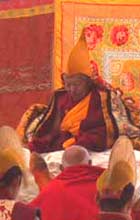
 The three Gelug monasteries of Sera, Drepung and Ganden were known collectively as the "Pillars of the State". As such there was naturally political rivalry between them. This can even be seen in the naming of this monastery. Sera, meaning "merciful hail" is a challenge to Drepung monastery, whose name means "rice heap" in the sense that hail damages rice. This rebellious monastery, some of whose monks were famed for their soldiery last challenged power in 1947. In the course of this failed coup, they even made an attempt on the then Regent's life.
The three Gelug monasteries of Sera, Drepung and Ganden were known collectively as the "Pillars of the State". As such there was naturally political rivalry between them. This can even be seen in the naming of this monastery. Sera, meaning "merciful hail" is a challenge to Drepung monastery, whose name means "rice heap" in the sense that hail damages rice. This rebellious monastery, some of whose monks were famed for their soldiery last challenged power in 1947. In the course of this failed coup, they even made an attempt on the then Regent's life.
Founded in 1419, at its height, Sera monastery was residence to more than 5,000 monks and five monastic colleges. Although much less active now, with only several hundred monks currently in residence, one of the most interesting times to visit the monastery is in the afternoon when monks, after finishing their morning scripture classes, can be seen debating in the courtyard.
The monastery is made up of a tsokchen (Great Hall), three tratsangs (colleges that offer specialised studies) and thirty khangtsens (residential compounds with chapels reserved for monks coming from different areas of Tibet).
The tsokchen is Sera's largest building and the administrative center of the monastery. Built in 1710, the central assembly hall houses a statue of Sakya Yeshe, the founder of Sera, flanked by sculptures of the Fifth and Thirteenth Dalai Lamas . To the rear of the central assembly hall are four floors, each filled with chapels dedicated to various gods as well as the monks' quarters.
Sera Me Tratsang, built in 1419 by Sakya Yeshe, specializes in teaching novices the fundamental precepts of Buddhism. Its assembly hall is famed for a copper sculpture of Sakyamuni (Historical Buddha) as well as for murals adorning the numerous chapels. Ngagpa Tratsang was also built in 1419 by Sakya Yeshe and is the monastery's Tantric college. Sera Je Tratsang is the monastery's largest college and was responsible for the instruction of itinerant monks from outside the region. The famous debating courtyard is located with this tratsang.